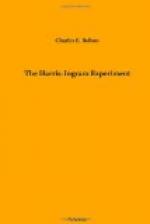Rembrandt was the son of a miller, and his studio was in his father’s wind-mill, where light came in at a single narrow window. By close observation he became master of light and shade, and excelled in vigor and realism. At $50 a year he taught pupils who flocked to him from all parts of Europe, but, like too many possessed of fine genius, he died in poverty. Later, London paid $25,000 for a single one of his six hundred and forty paintings. The Dutch painters put on canvas the everyday home-life and manners of their people, while the Flemish represented more the religious life of the lower Netherlands.
These journeys in Belgium gave Alfonso and Leo enlarged ideas as to the possibilities of portrait painting. In Alma Tadema, of Dutch descent, and Millais they saw modern examples of wonderful success, which made clear to them that the high art of portrait painting once acquired, both fame and fortune are sure to follow.
Christine de Ruyter had taken lessons of the best masters in Holland, Italy, and France. Few, if any women artists of her age, equalled or excelled her. Her conversations on art in the Netherlands charmed her two artist friends. She said, “The works of art of the fifteenth and seventeenth centuries in the Netherlands seemed to grow out of the very soil of the low countries. Our old artists revelled in the varied costumes and manifold types that thronged the cities of the Hanseatic League. The artist’s imagination was fascinated by the wealth of color he saw on sturdy laborers, on weather-beaten mariners, burly citizens, and sagacious traders.
“Rubens delighted often in a concentrated light, and was master of artistic material along the whole range. He painted well portraits, landscapes, battles of heroes, gallant love-making of the noble, and the coarse pleasures of the vulgar. Nearly a thousand pictures bear the name of Rubens.
“The artistic labor of Frans Hals of Haarlem extended over half a century. He possessed the utmost vivacity of conception, purity of color, and breadth of execution, as shown in his latest works, and so well did he handle his brush that drawing seems almost lost in a maze of color tone. The throng of genre painters, who have secured for Dutch art its greatest triumph, are well nigh innumerable.”
Christine was very fond of flower-pieces, and had painted lovely marguerites on Gertrude’s white dress, in Alfonso’s full length picture of his sister, which he was soon to carry to Paris as his wedding present.
Leo and Alfonso much wished to extend their journey north to Copenhagen and Stockholm, the “Venice of the North,” but letters urging a speedy return to the marriage of George and Gertrude in Paris, forced the two artists to shorten their journey, say good-bye to their kind friends of Amsterdam, and hasten back to Paris, taking portraits of their own skill as wedding gifts.




